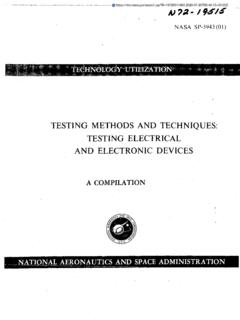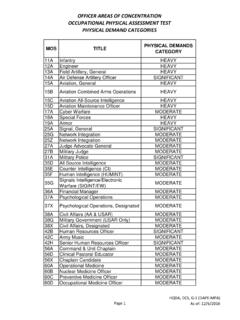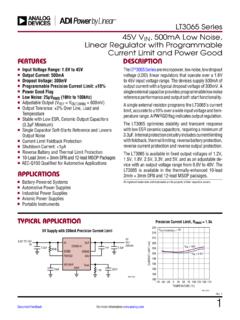Transcription of Root Raised Cosine (RRC) Filters and Pulse Shaping in ...
1 Root Raised Cosine (RRC) Filters and Pulse Shaping in Communication Systems Erkin Cubukcu Abstract This presentation briefly discusses application of the Root Raised Cosine (RRC) Pulse Shaping in the space telecommunication. Use of the RRC filtering ( , Pulse Shaping ) is adopted in commercial communications, such as cellular technology, and used extensively. However, its use in space communication is still relatively new. This will possibly change as the crowding of the frequency spectrum used in the space communication becomes a problem. The two conflicting requirements in telecommunication are the demand for high data rates per channel (or user) and need for more channels, , more users.
2 Theoretically as the channel bandwidth is increased to provide higher data rates the number of channels allocated in a fixed spectrum must be reduced. Tackling these two conflicting requirements at the same time led to the development of the RRC Filters . More channels with wider bandwidth might be tightly packed in the frequency spectrum achieving the desired goals. A link model with the RRC Filters has been developed and simulated. Using 90% power Bandwidth (BW) measurement definition showed that the RRC filtering might improve spectrum efficiency by more than 75%. Furthermore using the matching RRC Filters both in the transmitter and receiver provides the improved Bit Error Rate (BER) performance.
3 In this presentation the theory of three related concepts, namely Pulse Shaping , Inter Symbol Interference (ISI), and Bandwidth (BW) will be touched upon. Additionally the concept of the RRC filtering and some facts about the RRC Filters will be presented. Avionic Systems AnalysisRoot Raised Cosine Filters & Pulse Shaping in Communication SystemsErkin Cubukcu Friday, May 18, 2012 Avionic Systems Analysis25/7/2012 Outline Pulse Shaping , Intersymbol Interference (ISI), and Bandwidth Ideal Low Pass Filter (LPF) Raised Cosine (RC) Root Raised Cosine (RRC) Facts about RRC Link Modeling with the RRC Filters Signal Spectra BER Plots ConclusionsAvionic Systems AnalysisPulse Shaping , Intersymbol Interference (ISI), and Bandwidth35/7/2012 Digital ModulationAvionic Systems AnalysisPulse Shaping , Intersymbol Interference (ISI), and Bandwidth (con t) Theory45/7/2012 Two conflicting requirements!
4 : Demand for High data rates (more information). Need for Narrow Bandwidth (more users, more channels, less noise). If channels are too narrow the symbols will be too wide, hence. At sampling points (in time) there will be signal (tails) of the previous and next symbols. This is called Inter-symbol Interference (ISI) One possible solution is to use an Ideal Low Pass Filter (ILPF) (rectangular in frequency). Avionic Systems AnalysisIdeal Low Pass Filter (ILPF) No ISI Narrow bandwidth channel55/7/2012 IssuesPhysically unrealizable and difficult to attainable, require extreme precise synchronization, synchronization is a problem (jitter in the system might be detrimental).TtTt//sin Avionic Systems AnalysisSolution : Raised Cosine (RC) Filters It is shown by Nyquist that If the frequency characteristic has odd symmetry at the cutoff frequency, the impulse response will have zeros at uniformly spaced intervals.
5 Much simpler to attain Effects of jitter may be minimized65/7/2012 TfTfTTfTTTfTfH210212121cos12210)( )/4(1/cos//sin)(222 TtTtTtTtth (Eq. 1)(Eq. 2)Avionic Systems AnalysisPlot of Raised Cosine (RC) filter Frequency Response75/7/2012 Impulse ResponseAvionic Systems AnalysisRaised Cosine Filter (Cont) Impulse response now has a sinc term that ensures that it has zero crossings as like ideal low pass In addition, it has another term That decays in time hence reduces the tails reducing the impact of )/4(1/cos222 TtTt Avionic Systems AnalysisBandwidth of Raised Cosine (RC) Filter95/7/2012 Tttc/ SinceTB2/)1( cccffT2/1)2/(/ So the baseband transmission bandwidth If ideal LPF were used the baseband bandwidth would beTfBc2/1 Nyquist BandwidthTtTt//sin Where the sampling time is TTTTc/ Tc TffH210)
6 ( Bandwidth for a realizable RC filtercfB)1( Nyquist Bandwidth times 1 Avionic Systems AnalysisRoot Raised Cosine (RRC) Filter The overall channel transfer function must be Raised Cosine (RC) as discussed above. One way of achieving it is to take square root of the Raised Cosine filter in frequency domain and use this new filter in the Tx and Rx. This is the so called Root Raised Cosine 2)2/cos1(21)()( When the transmitter and receiver Filters are cascaded one gets Raised Cosine filter transfer characteristic)()()(,, rxrrctxrrcrcHHH )()()( rcrcrcHHH OrAvionic Systems AnalysisRoot Raised Cosine Filter (RRC) (con t) By taking square root of RC filter frequency response, one )/4(1/4]/)1sin[(]/)1cos[(2)(TtTtTtTtTth TfTfTTfTTTfTfH210212121cos12210)( Finding its impulse Response is a little bit tricky.)
7 Impulse response can also be generated numerically using Systems AnalysisFacts about RRC RRC theoretically has infinite number of taps so it has infinite attenuation in the stop band. However, in implementation its length should be reduced to a finite value. Decreasing the number of samples (filter delay) reduces the stop band attenuation. The rolloff factor is a measure of the excess bandwidth of the filter, , the bandwidth occupied beyond the Nyquist bandwidth of 1/2T, where 1/T is symbol rate. As rolloff increases eye in the eye diagram opens up. This means that if there were no bandwidth restrictions it would be easier on the receiver if one used a large rolloff. (However, for bandwidth efficiency rolloff should be smaller.)
8 Smaller rolloff gives narrower bandwidth. However, its side lobes increases so attenuation in stop band is reduced. RRC Filters are implemented in the base band as a digital filter. Since implementing narrow (high Q) Filters in the RF bands is Systems AnalysisFacts about RRC (cont.) Another issue to consider in Pulse Shaping is the Peak-to-Average Power Ratio (PAPR). PAPR is determined by combination of Modulation Constellation of the signal Pulse Shaping High PAPR reduces power amplifier efficiency since it must operate with large back off (higher PAPR requires higher back off and/or more linearity) PAPR of an RRC will increase with reduced excess bandwidth5 increased filter length5135/7/2012 Avionic Systems AnalysisLink Modeling with the RRC Filters145/7/2012A SIMULINK Model was developed and simulated to study the spectral efficiency and Bit Error Rate (BER) performance of the RRC Filters .
9 Below is a high level block diagram of this Systems AnalysisLink Modeling with the RRC Filters (Cont.)Tx Model with RRC Pulse Shaping155/7/2012 The modulator generates one symbol for each pair of data bits. The symbols generated by the modulator is up sampled and Pulse shaped (filtered) to comply with the channel bandwidth restrictions. Typically, the Pulse Shaping is the last stage of transmitter before (DAC and) Systems AnalysisLink Modeling with the RRC Filters (Cont.) Rx Model with RRC Filter 165/7/2012 RRC filter Filters out the signal ( , equalizes to give a nearly zero Intersymbol Interference, ISI, if Tx is also using RRC filter Pulse Shaping ). The output is sampled at the optimum points ( , down-sampled) to give one sample per constellation symbol.
10 Demodulator finds out which quadrant the received sample falls and based on that decision generates a pair of Systems AnalysisRC Filter Impulse Response, rolloff , , and 1 Symbol rate 1 Msps175/7/2012-4-3-2-101234-4-2024681012 14x 10-3 Raised Cosine Filter Responsetime ( s)Magnitude RC, rolloff , rolloff , rolloff 1 Avionic Systems AnalysisIdeal RRC Frequency Responsewith rolloff , , and 185/7/2012 Just the plot of the 106-100-90-80-70-60-50-40-30-20-100 Root Raised Filter ResponseFreq. (Hz)Mag. (dB) Ideal RRC, rolloff RRC, rolloff RRC, rolloff 1 Symbol rate 1 MbpsAvionic Systems AnalysisFrequency Response of Realizable Root Raised Cosine Filter with Rolloff , , and 1195/7 106-100-90-80-70-60-50-40-30-20-100 Root Raised Filter ResponseFreq.

















